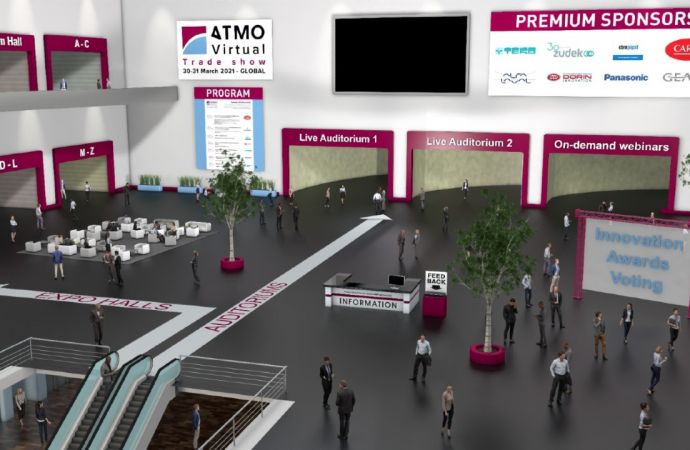Compressor developments, allowing to condense ammonia at 95ºC, have opened opportunities of using ammonia in industrial heat pumps. At an event organised by SIRAC last week, Dave Pearson of Star Refrigeration stressed the benefits of NH3 as a most viable replacement for HCFCs and HFCs in district heating and industrial production processes.

More than 30 members of the Sustainable Innovation in Refrigeration and Air Conditioning Industrial Academic Research Partnership Network (SIRAC) gathered on 2 December in Glasgow, Scotland to discuss recent trends in the industry, including the use of natural refrigerants. Dave Pearson of Star Refrigeration gave a presentation on the opportunities in using ammonia for industrial heat pumps, with ammonia being a known, competitively priced, environmentally friendly and future proof technology. Ammonia heat pumps are “F-gas ready”, and they will not be affected by any potential future ban on HFCs, or an increase in taxation that could see refrigerant prices increasing by £5-120 per kg.
Commenting after the event, Pearson said “what seems to now be recognised is that there are very few applications where a natural refrigerant is not a viable option. Whether small CO2 display cases, hospital chillers using ammonia like Great Ormond St, supermarket systems using CO2, spiral freezers using either CO2 or ammonia, or even large district heating systems using ammonia at 90°C these systems can be delivered without HFCs. Aside from typically being more robust systems that should last 20 years, the systems also tend to consume less power so there is an immediate saving to the customer.”
Efficient NH3 heat pump systems
Recent compressor developments offering high pressure compressors with balanced radial and axial forces suitable for condensing ammonia at 95ºC, have allowed Star Refrigeration to develop heat pump systems for applications such as leisure centres, hospitals, ice-rinks (combined heating and cooling), food processing (cooking and chilling) as well as district heating and cooling. Highly efficient 1 stage and 2 stage systems entailing low maintenance cost with the following characteristics have been developed:
1 stage system: Duty: 0.2 – 5.0MW
Coefficient of Performance > 4.5 at 65˚C
Heating: 40˚C - 60˚C
Cooling: +12/6˚C
2 stage system: Coefficient of Performance > 3.0 at 90˚C
Heating: +70˚C - 90˚C
Chilling: +12/6˚C
NH3 heat pump case studies
Star Refrigeration recently undertook a project whereby an R22 chill plant was replaced with a future proof natural refrigerant based system, with the system capturing as much waste heat as possible. A 1-stage ammonia heat pump of 435kW cooling and upto 607kW heating will be installed for the purpose. The heat pump achieves a Coefficient of Performance of 3.7, which is 7.7 times better than the combined efficiency of previously used gas boiler and steam system. Even with the price of electricity being 3 times higher than that of natural gas, the operational cost of the ammonia heat pump is only 60% of that of gas.
Pearson also presented the case study of one of the largest ammonia heat pumps ever designed to deliver hot water at 90˚C that the company foresees to install in the near future in Scandinavia. The system, providing heating in the temperature range between +70˚C and +95˚C and chilling at 12/6˚C, gives a Coefficient of Performance greater than 3 at 90˚C.
Pearson concluded, “what today has shown is that the closer the relationship between industry and academia, the further we can push the boundaries and the higher the end user value we can deliver”.
Commenting after the event, Pearson said “what seems to now be recognised is that there are very few applications where a natural refrigerant is not a viable option. Whether small CO2 display cases, hospital chillers using ammonia like Great Ormond St, supermarket systems using CO2, spiral freezers using either CO2 or ammonia, or even large district heating systems using ammonia at 90°C these systems can be delivered without HFCs. Aside from typically being more robust systems that should last 20 years, the systems also tend to consume less power so there is an immediate saving to the customer.”
Efficient NH3 heat pump systems
Recent compressor developments offering high pressure compressors with balanced radial and axial forces suitable for condensing ammonia at 95ºC, have allowed Star Refrigeration to develop heat pump systems for applications such as leisure centres, hospitals, ice-rinks (combined heating and cooling), food processing (cooking and chilling) as well as district heating and cooling. Highly efficient 1 stage and 2 stage systems entailing low maintenance cost with the following characteristics have been developed:
1 stage system: Duty: 0.2 – 5.0MW
Coefficient of Performance > 4.5 at 65˚C
Heating: 40˚C - 60˚C
Cooling: +12/6˚C
2 stage system: Coefficient of Performance > 3.0 at 90˚C
Heating: +70˚C - 90˚C
Chilling: +12/6˚C
NH3 heat pump case studies
Star Refrigeration recently undertook a project whereby an R22 chill plant was replaced with a future proof natural refrigerant based system, with the system capturing as much waste heat as possible. A 1-stage ammonia heat pump of 435kW cooling and upto 607kW heating will be installed for the purpose. The heat pump achieves a Coefficient of Performance of 3.7, which is 7.7 times better than the combined efficiency of previously used gas boiler and steam system. Even with the price of electricity being 3 times higher than that of natural gas, the operational cost of the ammonia heat pump is only 60% of that of gas.
Pearson also presented the case study of one of the largest ammonia heat pumps ever designed to deliver hot water at 90˚C that the company foresees to install in the near future in Scandinavia. The system, providing heating in the temperature range between +70˚C and +95˚C and chilling at 12/6˚C, gives a Coefficient of Performance greater than 3 at 90˚C.
Pearson concluded, “what today has shown is that the closer the relationship between industry and academia, the further we can push the boundaries and the higher the end user value we can deliver”.
MORE INFORMATION
Related stories




